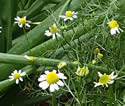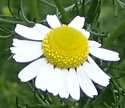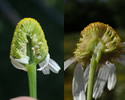Matricaria chamomilla (German Chamomile)
| Also known as: | Wild Chamomile, Scented Mayweed |
|---|---|
| Genus: | Matricaria |
| Family: | Asteraceae (Aster) |
| Life cycle: | annual |
| Origin: | Europe, Asia |
| Status: |
|
| Habitat: | sun; average to dry disturbed soil; roadsides, railroads, waste places, gardens |
| Bloom season: | June - October |
| Plant height: | 6 to 24 inches |
| Wetland Indicator Status: | none |
| MN county distribution (click map to enlarge): |  |
| National distribution (click map to enlarge): |  |
Pick an image for a larger view. See the glossary for icon descriptions.
Detailed Information
Flower: 

![[photo of flowers]](/udata/r9ndp23q/pd/matricaria-chamomilla-15-66-8-t.jpg) Daisy-type flowers, single at the tips of branching stems. Flowers are ½ to 1 inch across with 10 to 25 white petals (ray flowers) and a yellow to greenish-yellow center disk that expands from button-shaped to dome-shaped as it matures. The disk is hollow at the core.
Daisy-type flowers, single at the tips of branching stems. Flowers are ½ to 1 inch across with 10 to 25 white petals (ray flowers) and a yellow to greenish-yellow center disk that expands from button-shaped to dome-shaped as it matures. The disk is hollow at the core.
![[photo of bracts]](/udata/r9ndp23q/pd/matricaria-chamomilla-15-66-11-t.jpg) The bracts surrounding the base of the flower are in 3 layers, narrowly lance-oblong, green with membranous edging. Bracts and flower stalks are hairless.
The bracts surrounding the base of the flower are in 3 layers, narrowly lance-oblong, green with membranous edging. Bracts and flower stalks are hairless.
Leaves and stems: 


![[photo of leaves]](/udata/r9ndp23q/pd/matricaria-chamomilla-7-15-3-4-t.jpg) Leaves are ½ to 3 inches long, feathery with a few to numerous thread-like branching lobes. Stems are usually multiple from the base, erect to ascending, many branched in the upper plant, ribbed or lined, and hairless. Plants are aromatic when bruised.
Leaves are ½ to 3 inches long, feathery with a few to numerous thread-like branching lobes. Stems are usually multiple from the base, erect to ascending, many branched in the upper plant, ribbed or lined, and hairless. Plants are aromatic when bruised.
Fruit: 
The center disk becomes a round head of dry, gray-brown seed that lack tufts of hair. Seeds are less than 1mm long, cone-shaped to oblong, round in cross-section, have 3 to 5 white ribs, and gland-dotted (magnification required).
Notes:
German Chamomile, also known as Matricaria recutita, has a long history of medicinal uses, cultivated globally and occasionally escapes cultivation but is not known to invade high quality habitat. Of similar species, the related Pineapple-weed (M. discoidea) lacks ray flowers, Dog Fennel (Anthemis cotula) leaves have broader and flatter lobes and a distinct, unpleasant odor when crushed, and Scentless False Mayweed (Tripleurospermum inodorum) has larger flowers with a solid core on the disk and is not aromatic. Feel free to rip the disks open and see whether they're hollow or solid. These are all weeds, after all.
Native Plant Nurseries, Restoration and Landscaping Services ↓
More photos
 German Chamomile plant
German Chamomile plant German Chamomile plants
German Chamomile plants German Chamomile plants
German Chamomile plants German Chamomile plants
German Chamomile plants German Chamomile disk is hollow, compared to Scentless False Mayweed
German Chamomile disk is hollow, compared to Scentless False Mayweed
Photos by K. Chayka and Peter M. Dziuk taken in their gardens.
Comments
Have you seen this plant in Minnesota, or have any other comments about it?
on: 2021-07-13 14:41:18
I picked some chamomile flowers at nearby Minniwashta Regional Park and I want to make sure they are medicinal. The flowers are very small, slightly bluish and aromatic. The leaves are broader than on the picture, but the base is hollow. I can send you a picture when I hear from you.
on: 2021-07-14 08:08:34
Galina, if you'd like confirmation on an ID, please post your images on the Minnesota Wildflowers Facebook page.
on: 2022-09-15 10:04:58
Wondering how common wild German Chamomile is in Minnesota. The plant I saw is not part of the new prairie planting that was done by the county. It's along the back perimeter of the the new bathroom facility building. Looks like just a single plant.
on: 2022-09-15 13:29:45
Linda, weeds are introduced to new areas in many ways, such as on vehicle tires, footwear, dog fur and mowers in addition to wind, water, birds and other wildlife. If it's around a building, it likely came from human transport of some sort.






